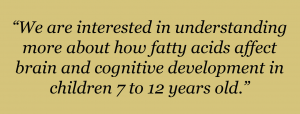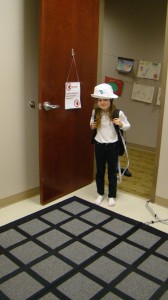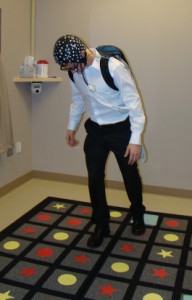The MAZE Study
By Kelly Shephard
We are busy here at the Cheatham Lab with three different studies. We’ve got toddlers, and older folk, and now even 7- to 12-year-olds! We always like it when we have lots of people coming to the lab, though. That’s why our new study with 7- to 12-year-olds is so much fun. We call it the MAZE study because we are testing our new game, a maze, where participants have to go from one end of the room to the other end of the room by figuring out which are the correct squares to step on. Here’s the scoop:
 We are interested in understanding more about how fatty acids affect brain and cognitive development in children 7 to 12 years old.
We are interested in understanding more about how fatty acids affect brain and cognitive development in children 7 to 12 years old.
There are a lot of omega-6 and omega-3 fatty acids in the brain that do a lot of important things for communication between neurons. We are trying to understand how the omega-6 and omega-3 fatty acids we eat might affect our cognitive abilities. Children who are 7-to 12-years-old are developing abilities called executive functions. These are higher-order functions used to regulate our behavior, emotion, and cognition. We use these kinds of functions for making decisions and solving complex problems. As adults, we use these functions all the time. Children start to develop these functions later in life than, say, memory, but these executive functions become very important functions for success in school and adult life.
What we are doing in our study.
We are asking participants to first talk to us on the phone three times about what they ate the day before the phone call. We use the information from these phone calls to determine if your child’s diet fits into one of our dietary groups. If your child fits into one of our groups, you would be invited to the in-person visit where your child would try out the MAZE and play some computer games that test executive functions.
 While they are playing the games and trying out the MAZE, we will collect brain imaging information. We are using near-infrared spectroscopy (NIRS) to collect information about what areas of the brain are active during the games. NIRS is an optical imaging technique, which means it uses light to read brain activity. Participants wear a cap, kind of like a swim cap, that has rubber holes in it. We place ‘sources’ and ‘detectors’ in the rubber holes. The ‘sources’ put out a light that the ‘detectors’ pick up on to read the brain activity. Light travels through the brain in a predictable way, and we can use the properties of light and of brain tissue to understand what areas are active during certain tasks. If you want to learn more about NIRS, I have a separate article in this newsletter to tell you more!
While they are playing the games and trying out the MAZE, we will collect brain imaging information. We are using near-infrared spectroscopy (NIRS) to collect information about what areas of the brain are active during the games. NIRS is an optical imaging technique, which means it uses light to read brain activity. Participants wear a cap, kind of like a swim cap, that has rubber holes in it. We place ‘sources’ and ‘detectors’ in the rubber holes. The ‘sources’ put out a light that the ‘detectors’ pick up on to read the brain activity. Light travels through the brain in a predictable way, and we can use the properties of light and of brain tissue to understand what areas are active during certain tasks. If you want to learn more about NIRS, I have a separate article in this newsletter to tell you more!
If you or your children are interested, please contact us!
Give us a call at 704-250-5028 or email me at Kelly_sheppard@unc.edu to set up a time to talk more about it. I look forward to hearing from you!

